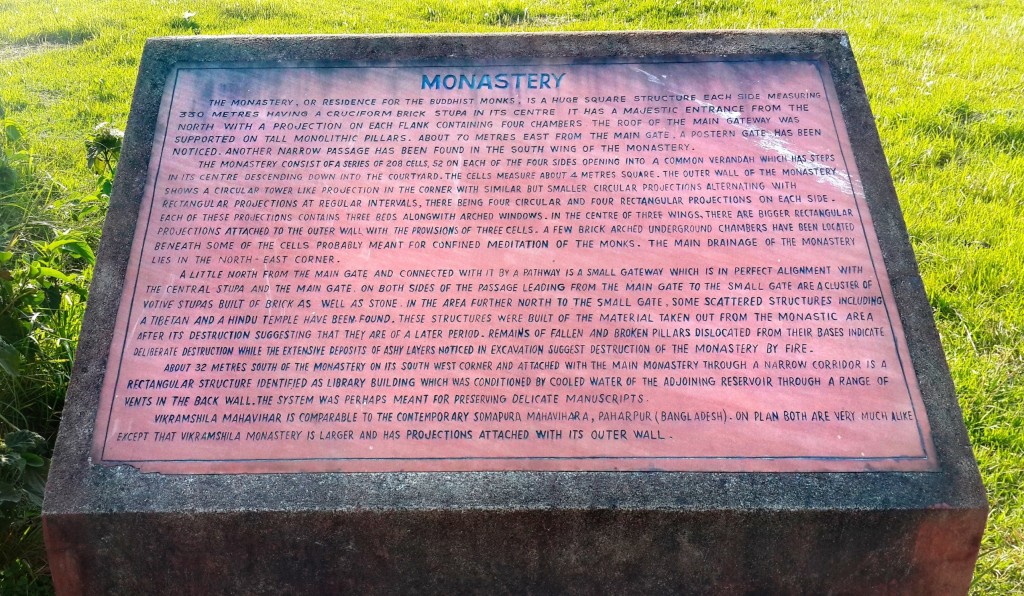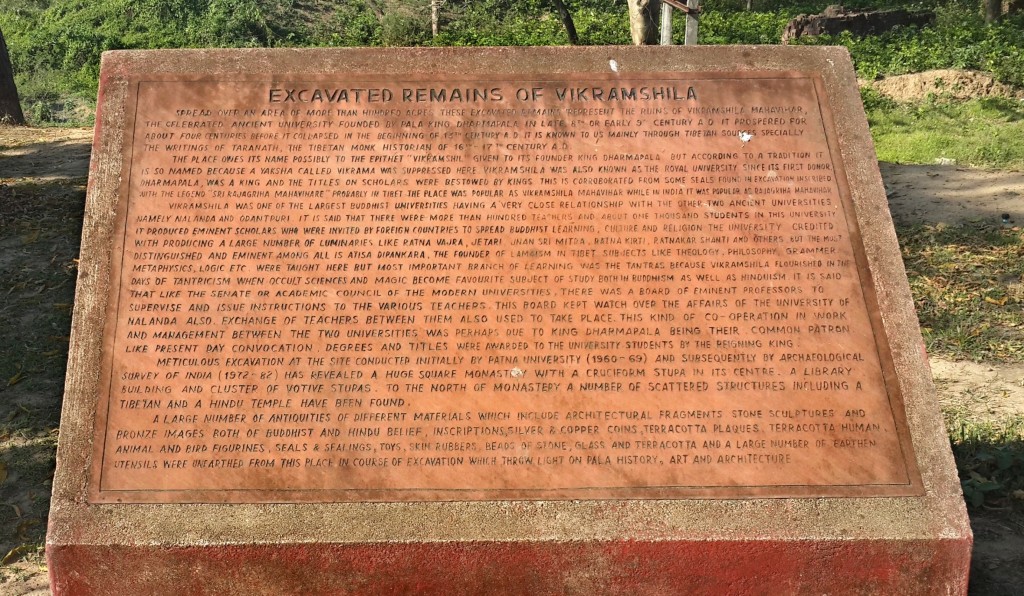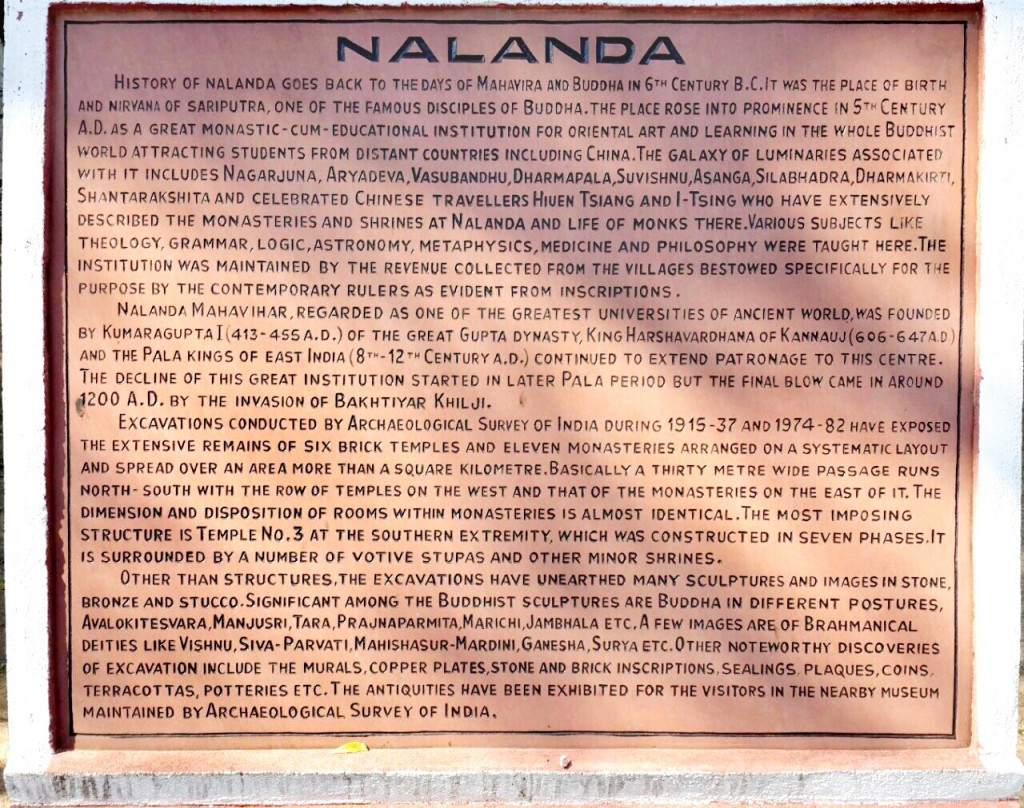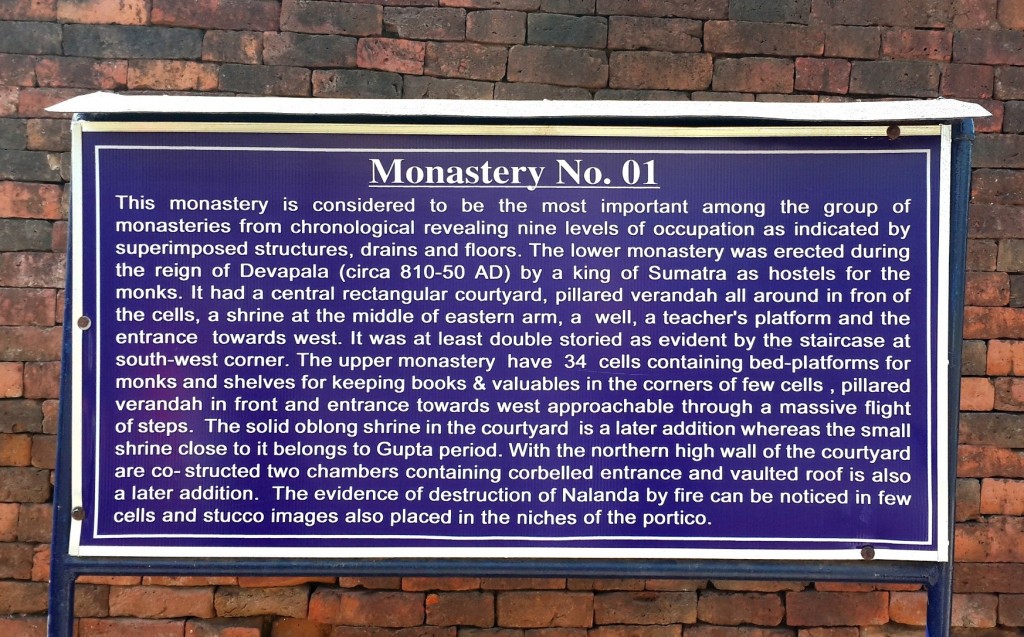
(1) || svasti °çrī çakavarṣātīta 606 dim dvitīya çuklapaksa vulan caitra ° sāna tatkālāna parlak çrīkṣetra ini ° niparvuat
May all be well! In the year Saka 606, on the second day of the clear fortnight of the month of Caitra: It was at that time that the park Sriksetra was built
| svasti | : | auspicious, well-being |
| çrī | : | sri : honorific title/term, beautiful |
| çaka varṣā tīta | : | çaka : Saka, calendar era |
| varṣā : year | ||
| atīta : past | ||
| dvitīya | : | second |
| çukla | : | bright |
| paksa | : | half |
| vulan | : | moon |
| caitra | : | name of the ninth month |
| sāna | : | there |
| tat kālā | : | that time |
| na | : | suffix: at |
| parlak | : | park |
| çrī kṣetra | : | noble park |
| ini | : | this |
| ni parvuat | : | was made |
(2) parvāṇḍa punta hiyaṃ çrī jayanāça ° ini pranidhānāṇḍa punta hiyaṃ ° savañakña yaṃ nitānaṃ di sini° ñiyur pinam hanāu ru-
under the auspices of Punta Hyang Sri Jayanasa. Here are the aspirations of Punta Hyang: That everything that is planted here – coconut, betel palm, sugar palm,
| par-vdā-ṇḍa | : | the auspices of |
| punta | : | title for king/nobility |
| hiyaṃ | : | honorific for the divinity |
| çrī jayanāça | : | the king’s name |
| ini | : | this |
| pranidhānā | : | vows, desire, aspiration |
| ṇḍa | : | his |
| savañakña | : | as many as, all |
| yaṃ | : | which |
| ni tānaṃ di sini | : | planted here |
| ñiyur | : | coconut |
| pinam | : | betel, areca palms |
| hanāu | : | sugar, toddy palm |
(3) mviya dṅan samiçrāna yaṃ kāyu nimākan vuaḥña° tathāpi haur vuluh pattuṃ ityevamādi ° punarapi yaṃ parlak vukan
sago palm, all varieties of trees with edible fruits, as well as haur bamboo, waluh bamboo, pattum bamboo, and many other plants – together with many other parks
| rumviya | : | sago |
| dṅan | : | with |
| samiçrāna | : | various |
| yaṃ | : | which |
| kāyu | : | wood, trees |
| nimākan | : | eaten/edible |
| vuaḥña | : | their fruits |
| tathāpi | : | but |
| haur | : | aur bamboo |
| vuluh | : | wuluh bamboo |
| pattuṃ | : | petung bamboo |
| ityevamādi | : | iti ewam adi : and others |
| punarapi | : | also |
| yaṃ | : | which |
| parlak | : | park |
| vukan | : | the other |
(4) dṅan tavad talāga savañakña yaṃ vuatku sucarita parāvis prayojanākan puṇyāña sarvvasatva sacarācara varopāyāña tmu
with embankments and ponds, and all other excellent good deeds done by me, are dedicated to the benefit of all beings, and be for them whatever way best to reach
| dṅan | : | with |
| tavad | : | embankments |
| talāga | : | lake |
| sa vañak ña | : | as many as possible |
| yaṃ | : | which |
| vuatku | : | my making, done by me |
| sucarita | : | good deeds |
| parāvis | : | excellent |
| prayojanā kan | : | intending to, dedicated to |
| puṇyā ña | : | punya: merit, benefit |
| nya | : | theirs |
| sarvva satva | : | sarva : all |
| satwa : beings | ||
| sacarācara | : | whatever way |
| varopāyāña | : | best means |
| tmu | : | meeting |
(5) sukha ° di āsannakāla di antara mārgga lai° tmu muaḥ ya āhāra dṅan āir niminuṃña ° savañakña vuatña huma parlak mañcak mu-
happiness. In the middle of their journey, may they never be short of foods and water to drink. May all of their cultivated fields and parks be bountiful.
| sukha | : | happiness, joy |
| di | : | at |
| āsannakāla | : | āsana : sitting |
| : | kala : time, occasion | |
| di | : | at |
| antara | : | in the middle |
| mārgga | : | road |
| lai | : | other |
| tmu | : | meeting |
| muaḥ | : | also, again |
| ya | : | he/she |
| āhāra | : | food |
| dṅan | : | with |
| āir | : | water |
| ni minuṃ ña | : | be drunk by them |
| savañakña | : | all |
| vuatña | : | their making, done by them |
| huma | : | swidden field |
| parlak | : | park |
| mañcak | : | bountiful |
(6) aḥ ya maṃhidupi раçu prakāra ° marhulun tuvi vṛddhi muaḥya jāñan ya niknāi savañakña yaṃ upasargga °pīḍanu svapnavighna ° varaṃ vua-
May many livestock they keep flourish, and their helpers prosper. May they not be afflicted by any kind of calamity nor suffering which gives them sleeplessness. Whatever they should be doing,
| muaḥ | : | also, again |
| ya | : | he/she |
| maṃhidupi | : | raise |
| раçu | : | livestock |
| prakāra | : | amount, many |
| marhulun | : | servant |
| tuvi | : | also |
| vṛddhi | : | grow, abundance |
| muaḥ | : | also, again |
| ya | : | he/she |
| jāñan | : | may not be |
| ya | : | he/she |
| ni knāi | : | afflicted by |
| sa vañak ña | : | everything |
| yaṃ | : | which |
| upasargga | : | misfortune, danger, calamity |
| pīḍanu | : | torture, torment |
| svapna | : | dream, sleep |
| vighna | : | impediment, obstacle |
| varaṃ | : | whatever |
(7) tāña kathamapi ° anukūla yaṃ graha nakṣatra parāvis diya ° nirvyādhi ajara kavuatanāña ° tathāpi savañakña yaṃ bhrtyāña
may they be successful. May all the planets and constellations be favourable to them, and they be spared from illness, have long lives and maintain their strength. And also, that all the helpers
| vuatā ña | : | action, should do |
| ña | : | their |
| kathamapi | : | however |
| anukūla | : | in tune, favourable |
| yaṃ | : | which |
| graha | : | planet |
| nakṣatra | : | constellation |
| parāvis | : | excel |
| diya | : | he/she |
| nirvyādhi | : | completion |
| ajara | : | not aged, youthful |
| kavuatanāña | : | their strength |
| tathāpi | : | but, nevertheless |
| savañakña | : | everything |
| yaṃ | : | which |
| bhrtyāña | : | followers, assistants, servants |
(8) satyārjjava dṛḍhabhakti muaḥ ya dya ° yaṃ mitrāña tuvi jāñan ya kapaṭa yaṃ viniña mulaṃ anukūla bhāryyā muaḥ ya ° varam sthā
be faithful and devoted, and that their friends do not betray them, and that their wives be supportive spouses to them. In addition, wherever they are
| satyārjjava | : | loyal, sincere |
| dṛḍhabhakti | : | strong devotion |
| muaḥ | : | also, again |
| ya | : | he/she |
| dya | : | his/her |
| yaṃ | : | which |
| mitrāña | : | their friends |
| tuvi | : | also |
| jāñan | : | do not |
| ya | : | he/she |
| kapaṭa | : | betray |
| yaṃ | : | which |
| viniña | : | his wife |
| mulaṃ | : | the root, the source |
| anukūla | : | in tune, supportive, propitious |
| bhāryyā | : | wife, lady |
| muaḥ | : | also, again |
| ya | : | he/she |
| varam | : | goods, possession |
(9) naña lāgi cūri ucca vadhāña ° paradāra di sāna ° punarapi tmu ya kalyāṇamitra ° marvvaṅun vodhicitta dṅan maitri
let there be no theft, no deception and no adultery. What is more, may they meet noble skillful friends (kalyanamitra), cultivate the mind to achieve Awakening for the benefit of all beings (bodhicitta) through loving-kindness (maitri)
| sthānaña | : | standing |
| lāgi | : | again, also |
| cūri | : | to steal, burglar |
| ucca | : | prideful, exaggeration |
| vadhāña | : | mouth, to talk |
| paradāra | : | adultery, somebody else’s wife |
| di sāna | : | over there |
| punarapi | : | moreover, furthermore |
| tmu | : | meeting |
| ya | : | he/she |
| kalyāṇamitra | : | noble skillful friend |
| marvvaṅun | : | cultivate, rise |
| vodhicitta | : | bodhi : awakening |
| citta : mind | ||
| dṅan | : | with |
| maitri | : | good-will, loving-kindness |
(10) dhāri di daṃ hyaṃ ratnatraya jañan marsārak dṅan daṃ hyam ratnatraya ° tathāpi nityakāla tyāga marçila kṣānti marvvañun vīryya rājin
counting on the Three Jewels, and may they not become separated from the Three Jewels. And also, may they continuously practice generosity without any attachment (tyaga), live ethically with the commitment to not harm and non-violence (sila), with unangered forbearance (ksanti), that in them be born the diligent energy for their joyous efforts in doing good (virya).
| dhāri | : | from |
| di | : | in, at |
| daṃ | : | honorific |
| hyaṃ | : | honorific for the divinity |
| ratnatraya | : | Three Jewels |
| jañan | : | don’t do |
| marsārak | : | scatter, separated from |
| dṅan | : | with |
| daṃ | : | honorific |
| hyaṃ | : | honorific for the divinity |
| ratnatraya | : | Three Jewels |
| tathāpi | : | but, nevertheless |
| nitya | : | never change, always |
| kāla | : | time |
| tyāga | : | generosity without attachment to one’s possession |
| marçila | : | mar : with |
| çila : non-violent ethical living with commitment not to harm | ||
| ksānti | : | unangered forbearance, tolerant endurance |
| marvvañun | : | to cultivate |
| vīryya | : | energetic joyous effort in doing good |
| rājin | : | diligent |
(11) tāhu di samiçrāña çilpakalā parāvis ° samāhitacinta ° tmu ya prajñā° smṛti medhāvi ° punarapi dhaiṛyyamānī mahāsattva
Knowledgeable of various kinds of arts; may they excel with an analytical focused mind (samahitacinta), possessing insights and wisdom (prajna); most importantly that they always be present, mindful, with recollection and vigilant (smrti). And, in addition, that they have steadfast conviction and possess the vajra body of the Great Beings (mahasattva),
| tāhu | : | knowing |
| di | : | about |
| samiçrāña | : | all different kinds |
| çilpakalā | : | arts, crafts-persons, creations |
| parāvis | : | excel |
| samāhitacinta | : | samāhita : focused awareness |
| cinta : thought, analysis, reflection | ||
| tmu | : | meeting |
| ya | : | he/she |
| prajñā | : | insight, deeper wisdom |
| smṛti | : | attentive presence and recollection |
| medhāvi | : | salient, most important |
| punarapi | : | in addition, moreover, furthermore |
| dhaiṛyyamānī | : | steadfast conviction |
| mahāsattva | : | great being |
(12) vajraçarīra ° anupamaçakti ° jaya ° tathapi jātismara ° avikalendriya ° mañcak rupa ° subhaga hāsin halap ° ade-
with incomparable power, glorious, and the knowledge of their former lives, with unimpaired senses, full form, happiness, smiles and tranquility,
| vajraçarīra | : | vajra body |
| anupamaçakti | : | anupama: incomparable |
| çakti | : | power |
| jaya | : | victorious, superior |
| tathapi | : | but, nevertheless |
| jātismara | : | knowledge of previous existences |
| avikalendriya | : | unimpaired senses |
| mañcak | : | bountiful, full, fat |
| rupa | : | appearance, form |
| subhaga | : | fortunate, happy |
| hāsin | : | smile, laughter, radiant |
| halap | : | tranquil, calm |
(13) yavākya ° vrahmasvara ° jādi lāki ° svayambhu ° puna[ra]pi tmu ya cintāmaṇinidhāna ° tmu janmavaçitā ° karmmavaçita ° kleçavaçitā
with agreeable speech, the voice of Brahma. May they be male. Naturally arisen by their own accord; may they become Wish Granting Jewels for whomever they meet, enjoy the mastery of birth, the mastery of karma and the mastery of negative emotions.
| adeyavākya | : | ade : agreeable, pleasant |
| vākya : speech, sayings | ||
| vrahma | : | Brahma |
| svara | : | sound, voice |
| jādi | : | become |
| lāki | : | husband, male |
| sva yambhu | : | naturally arisen by its own accord |
| puna[ra]pi | : | moreover, furthermore |
| tmu | : | meeting |
| ya | : | he/she |
| cintāmaṇi | : | wish granting jewel |
| nidhāna | : | receptacle, treasure |
| tmu | : | meeting |
| janmavaçitā | : | janma : birth |
| vaçitā :mastery, to subjugate | ||
| karmavaçita | : | karma : karma, action |
| vaçitā : mastery, to subjugate | ||
| kleçavaçitā | : | kleça : afflictive mental state, negative emotion |
| vaçitā : mastery, to subjugate |
(14) avasāna tmu ya anuttarābhisamyaksaṃvodhi ||
And that in the end, they obtain the Highest, Complete and Perfect Awakening.
| avasāna | : | finally |
| tmu | : | meeting |
| ya | : | he/she |
| anuttarā | : | none higher |
| abhi | : | complete, great |
| samyaksaṃ | : | perfect |
| vodhi | : | awakening |
English:
- May all be well! In the year Saka 606, on the second day of the clear fortnight of the month of Caitra: It was at that time that the park Sriksetra was built
- under the auspices of Punta Hyang Sri Jayanasa. Here are the aspirations of Punta Hyang: That everything that is planted here – coconut, betel palm, sugar palm,
- sago palm, all varieties of trees with edible fruits, as well as haur bamboo, waluh bamboo, pattum bamboo, and many other plants – together with many other parks
- with embankments and ponds, and all other excellent good deeds done by me, are dedicated to the benefit of all beings, and be for them whatever way best to reach
- happiness. In the middle of their journey, may they never be short of foods and water to drink. May all of their cultivated fields and parks be bountiful.
- May many livestock they keep flourish, and their helpers prosper. May they not be afflicted by any kind of calamity nor suffering which gives them sleeplessness. Whatever they should be doing,
- may they be successful. May all the planets and constellations be favourable to them, and they be spared from illness, have long lives and maintain their strength. And also, that all the helpers
- be faithful and devoted, and that their friends do not betray them, and that their wives be supportive spouses to them. In addition, wherever they are
- let there be no theft, no deception and no adultery. What is more, may they meet noble skillful friends (kalyanamitra), cultivate the mind to achieve Awakening for the benefit of all beings (bodhicitta) through loving-kindness (maitri)
- counting on the Three Jewels, and may they not become separated from the Three Jewels. And also, may they continuously practice generosity without any attachment (tyaga), live ethically with the commitment to not harm and non-violence (sila), with unangered forbearance (ksanti), that in them be born the diligent energy for their joyous efforts in doing good (virya).
- Knowledgeable of various kinds of arts; may they excel with an analytical focused mind (samahitacinta), possessing insights and wisdom (prajna); most importantly that they always be present, mindful, with recollection and vigilant (smrti). And, in addition, that they have steadfast conviction and possess the vajra body of the Great Beings (mahasattva),
- with incomparable power, glorious, and the knowledge of their former lives, with unimpaired senses, full form, happiness, smiles and tranquility,
- with agreeable speech, the voice of Brahma. May they be male. Naturally arisen by their own accord; may they become Wish Granting Jewels for whomever they meet, enjoy the mastery of birth, the mastery of karma and the mastery of negative emotions.
- And that in the end, they obtain the Highest, Complete and Perfect Awakening.
***
Translated into English by Sudimuja and Jinabhumi team. April 2019.
Reference:
Cœdès, Georges (1930). Les inscriptions malaises de Çrīvijaya. Bulletin de l’Ecole française d’Extrême-Orient. Tome 30, pp. 29-80.
 Bahasa
Bahasa
 May 19th, 2019
May 19th, 2019  SUDIMUJA
SUDIMUJA 


